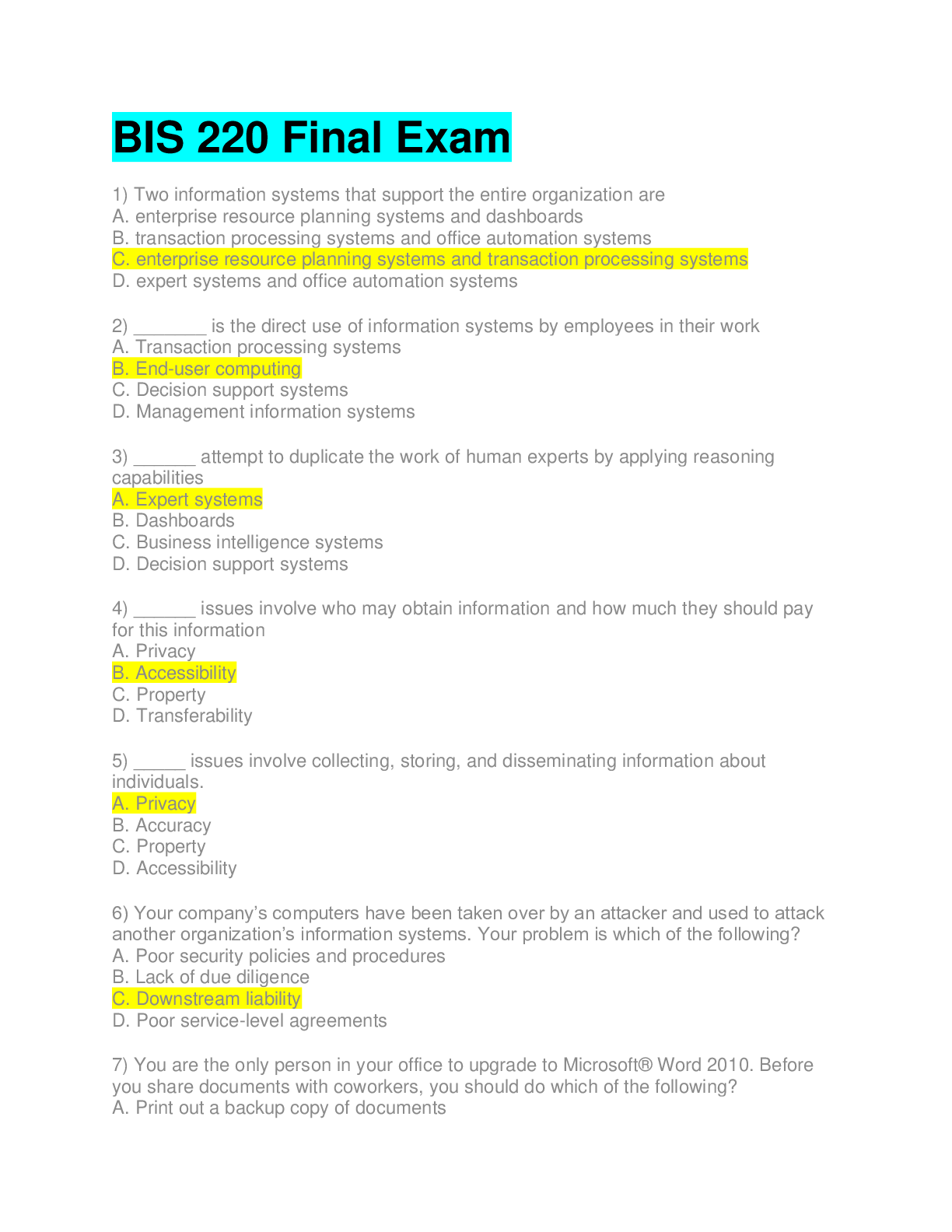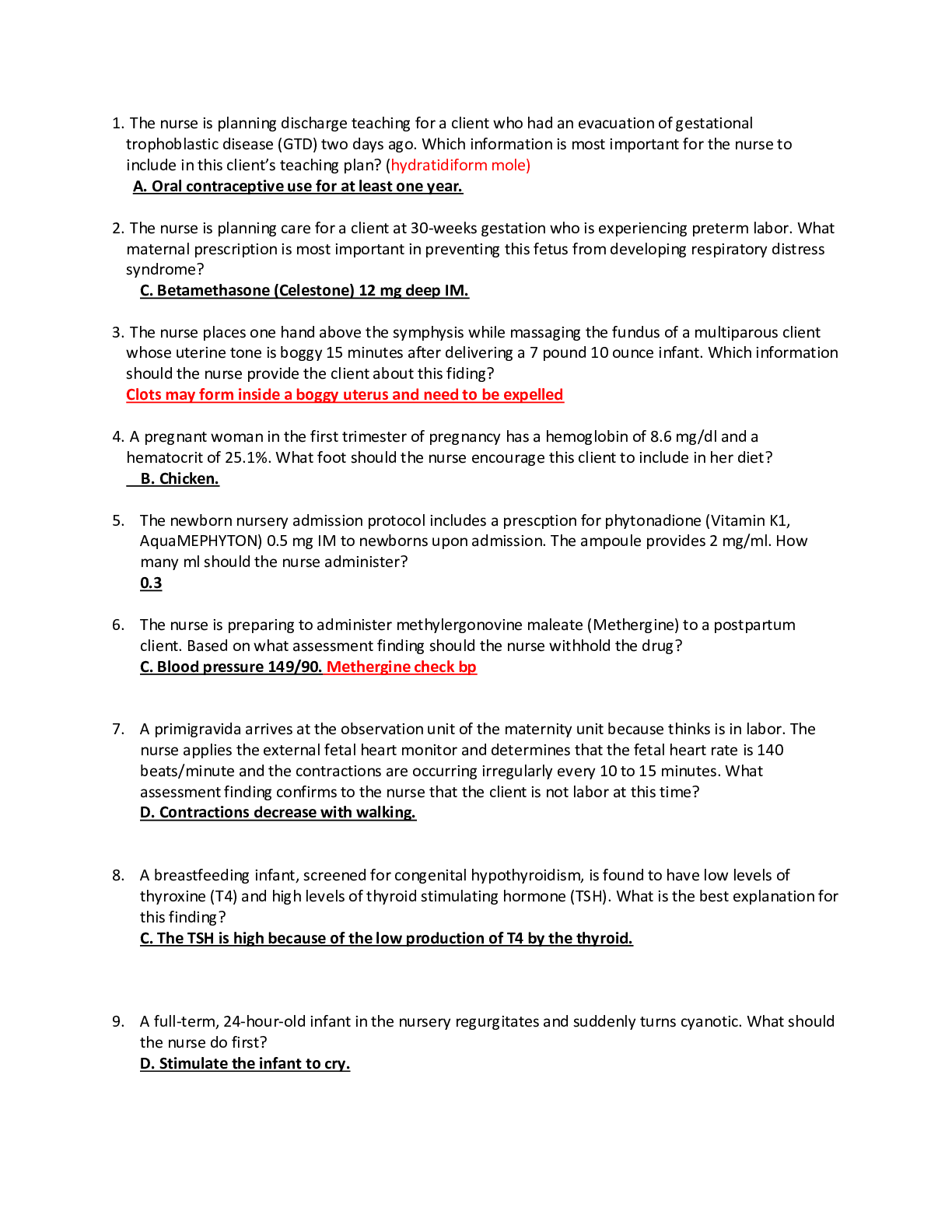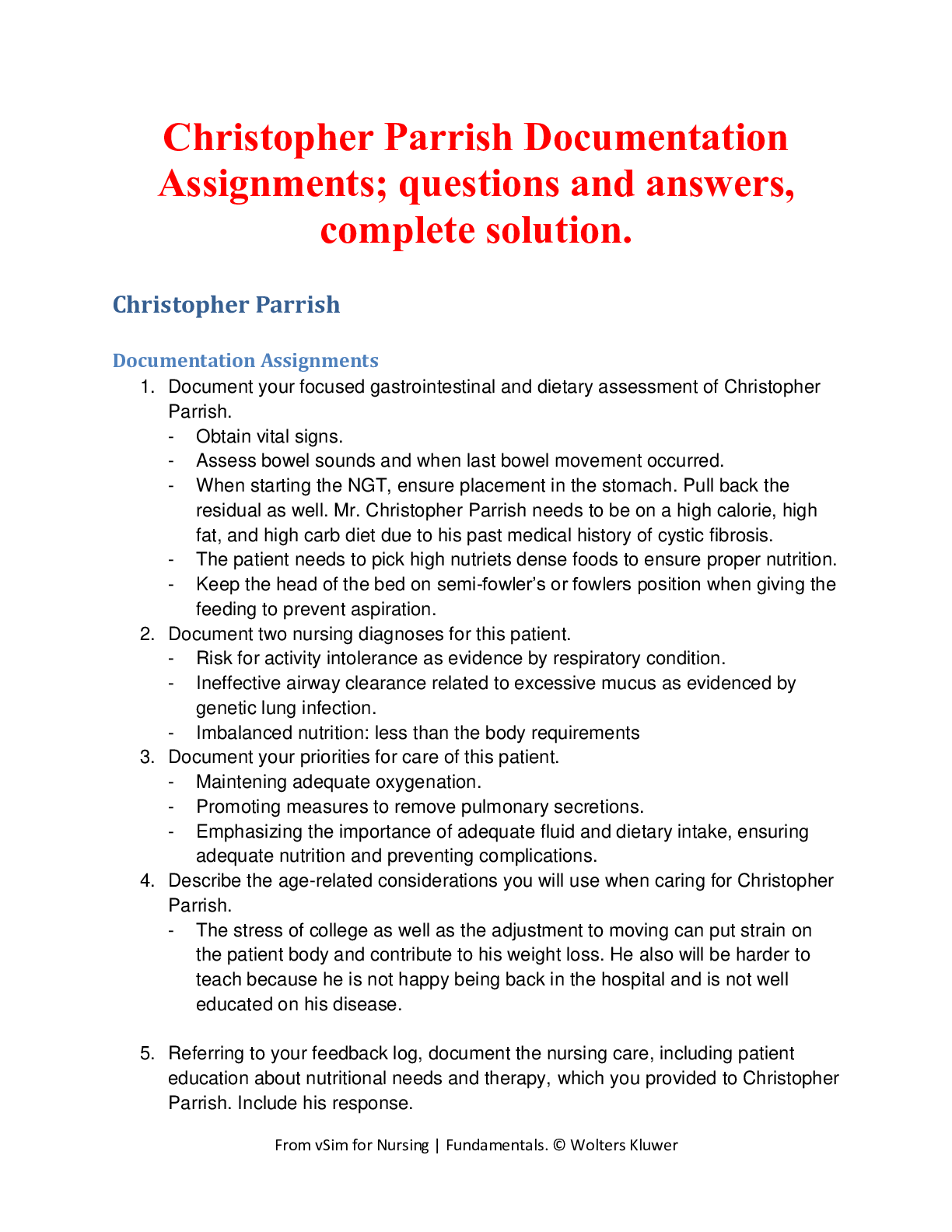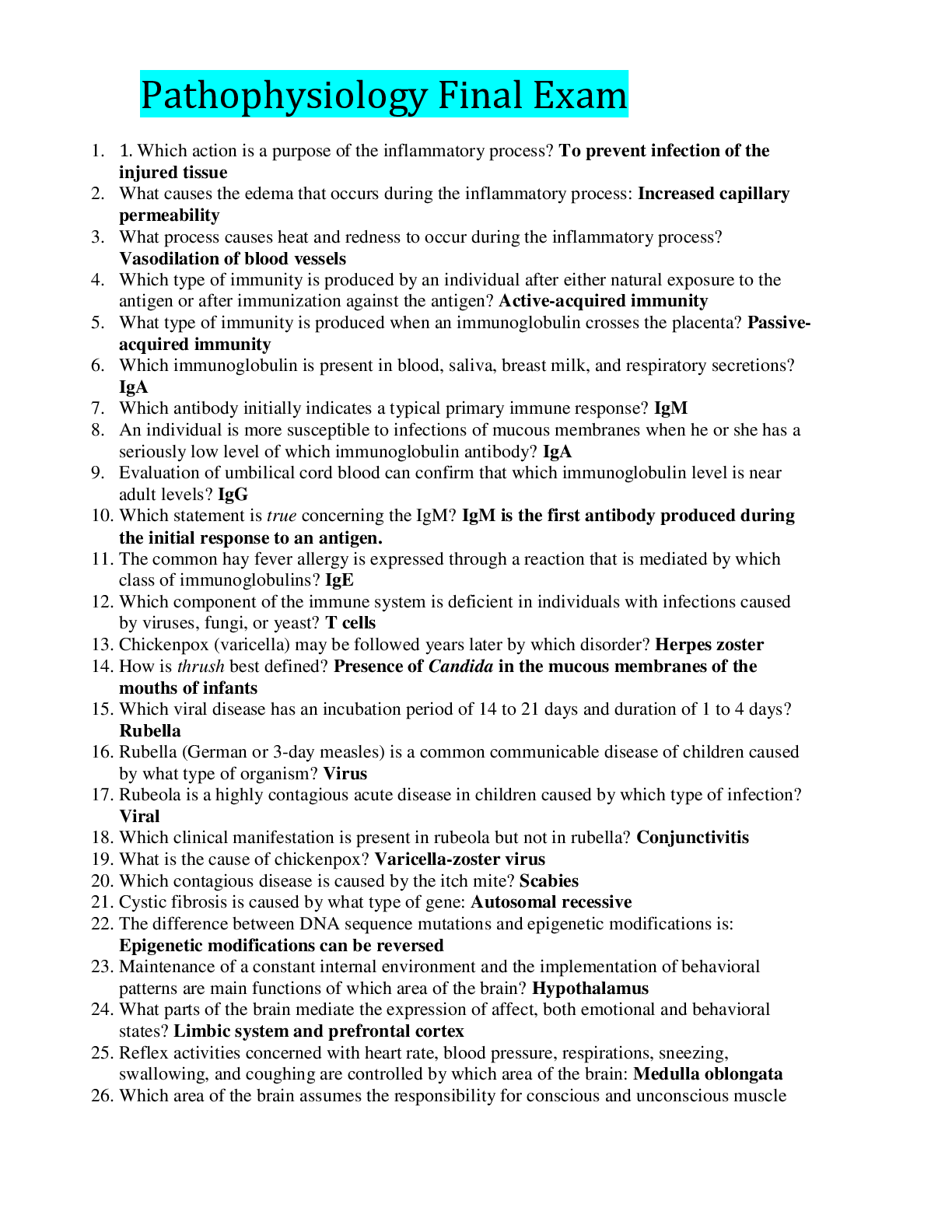*NURSING > QUESTIONS & ANSWERS > Patient/Client Care Management Final Exam Questions and answers, 2022 update. Graded A+ (All)
Patient/Client Care Management Final Exam Questions and answers, 2022 update. Graded A+
Document Content and Description Below
Patient/Client Care Management Final Exam Questions and answers, 2022 update. Graded A+ When measuring a wheelchair you need to look at what ? - ✔✔seat width seat depth leg length seat hei... ght arm rest height back height What happens if the seat depth is too low? - ✔✔trunk will be less stable What happens if the seat depth is too high? - ✔✔increased pressure on the popliteal area What happens if the seating is too low? - ✔✔difficult to perform transfers What happens if the seating is too high? - ✔✔the trunk is insufficiently supported What happens if the seat is too wide? - ✔✔difficulty reaching the hand rims to propel the wheel chair What happens if the seat is too narrow? - ✔✔excessive pressure on the greater trochanters (hips) What happens if the leg length is too low? - ✔✔pressure on the posterior aspect of distal femur What happens if the leg length is too high? - ✔✔increased pressure on ischial tuberosities What happens if the back height is too low? - ✔✔decreased trunk stability What happens if the back height is too high? - ✔✔difficulty propeling the chair because it will be more difficult to use the arms comfortably What happens if the arm rest height is too low? - ✔✔posture issues, inadequate balance, and difficulty pushing from sit to stand What happens if the arm rest height is too high? - ✔✔difficulty reaching hand rims What is the difference between a semi-reclining wheelchair, fully reclining wheelchair, and a tilt in space wheelchair? - ✔✔-A semi-reclining wheelchair can be reclined to 30 degrees of extension and brought to an upright position. -A fully reclining wheelchair can go to a fully flat position. The rear wheels need to be placed more posterior to prevent the wheelchair from tippy backwards. -A tilt in space wheelchair: the whole seat tilts back to allow for pressure relief. This is used for clients who are unable to perform pressure relief. What is the difference between an externally powered wheelchair, sports wheelchair, and lightweight/ultralight wheelchair? - ✔✔-Externally powered wheelchairs are powered by one or more deep-cycle batteries that provide stored electrical energy. Used for clients who have insufficient strength to propel a standard chair. Various controls can be used such as hand control, chin, head, tongue, mouth, sip and puff. -Sports wheelchairs can be customized for sporting activities. They are very light weight, strong, and highly maneuverable. -A lightweight or ultralight wheelchair is a solid, rigid frame, that doesn't have additional hardware mechanisms of a standard wheelchair. How do you measure seat width? - ✔✔Measure the widest aspect of the user's buttocks, hips, or thighs ADD 2 inches for bulky clothing and clearance of the greater trochanters from the armrest panels. Average = 18 inches How do you measure seat depth? - ✔✔Measure from the posterior buttocks, along the lateral thigh, to the popliteal fold SUBTRACT 2 inches to avoid pressure from the seat against the popliteal space. Average = 16 inches How do you measure leg length? - ✔✔Measure from the bottom of the user's heel (with the shoes on) to the popliteal fold No adding or subtracting Average = 17.5-18.5 inches How do you measure seat height? - ✔✔ADD 2 inches to the leg length measurement to allow for clearance of the footplates Average = 19.5-20.5 inches How do you measure back height? - ✔✔Measure from the seat of the chair to the floor of the axilla with the user's shoulder flexed to 90 degrees and then subtract 4 inches. The top edge of the seat back should fall below the inferior angles of the scapulae. If a seat cushion is to be used, this will need to be added. How do you measure Armrest height? - ✔✔Measure from the seat of the chair to the olecranon process with the user's elbow flexed to 90 degrees ADD 1 inch (This measurement will be different if a cushion is used). Average = 9 inches above the chair seat Proper seat depth can be determined by: A. placing 2 or 3 fingers between the front edge of the seat and the patient's popliteal fold (your hand parallel to the floor) B. placing your hand vertically between the patient's greater trochanter or hip and the armrest panel C. Placing 4 fingers between the front edge of the seat and the patients popliteal fold D. Placing your hand horizontal between the patient's greater trochanter or hip and the armrest panel - ✔✔A. placing 2 or 3 fingers between the front edge of the seat and the patient's popliteal fold (your hand parallel to the floor) All of the following are adverse effects if the seat of a wheelchair is too high except: A. increased pressure on ischial tuberosities B. poor posture when patient rests forearms on armrest C. insufficient trunk support D. difficulty position knees beneath table - ✔✔A. increased pressure on ischial tuberosities What are the phases of the stance phase? - ✔✔1. Initial contact (heel strike) 2. leading response (foot flat) 3. midstance 4. terminal stance (need great toe extension) 5. pre-swing (toe off) what are the phases of the swing phase? - ✔✔6. initial swing (acceleration; need dorsiflexion) 7. mid-swing 8. terminal swing (deceleration; need extension & dorsiflexion) Phase of Gait: when do falls most likely occur? - ✔✔Terminal Stance Weight Bearing Terminology: -NWB -TTWB -TDWB -PWB -WBAT -FWB - ✔✔-non weight bearing -toe touch weight bearing -touch down weight bearing -partial weight bearing -weight bearing as tolerated -full weight bearing Ambulation Progession (most stable to least) - ✔✔1. Parallel Bars (most stable) 2. assistive devices (walker->crutches->cane) 3. different surfaces (level, uneven, elevated) Assistive Devices: most Stable to least - ✔✔o Parallel bars o Walkers (no wheels) o Walkers (w/ wheels) o Axillary crutches o Forearm crutches o Hemi-walker o Quad-based cane o Single-point cane Assistive Devices: walker -advantages -disadvantages -type - ✔✔-advantages: provides most amount of stability; easy to manage; can add platform attachment -disadvantage: difficult to use on uneven surfaces & stairs; difficult to perform normal gait pattern; reduced speed of ambulation -types: rolling, reciprocal, standard Assistive Devices: Crutches -advantages -disadvantages - ✔✔-advantages: can be used for all gait patterns; easily stored & transported; allows greater speeds of ambulation -disadvantages: requires more coordination & balance; can cause pressure on axillary region; must have functional strength in UE/trunk Assistive Devices: Loftstrand crutches -advantages -disadvantages -commonly used for - ✔✔-advantages: can be used for all gair patterns, easy to handle, less trunk stability required than axillary crutches; cuff remains on arm when patient reaches for object; eliminates danger to axillary region -disadvantages: increased UE strength & trunk control; provides less stability than axillary crutches; requires functional standing balance -patients w/ neurological conditions Assistive Devices: canes & heliwalkers -advantages -disadvantages -where does device go -type (of canes) - ✔✔-advantages: light weight; increased social acceptance; more functional on stairs -disadvantage: decreased BOS; not used w/ NWB; only WBAT/FWB - AD goes on unaffected side -types: large/small base quad, singe point What are some pre-ambulatory activities before selecting an assistive device? - ✔✔Sit-to-stand Balance Weight-shifting Therapeutic exercise How do you a confirmation fit for assistive devices? - ✔✔-ask patient how tall they are to pre-adjust device -confirmation of fit while patient stands -elbow flexion at 20-25 degrees; handgrips at wrist crease/ulnar styloid process/greater trochanter -The device should be pre-set to an appropriate length prior to standing the patient up for the first time. -Perhaps the height will be correct when the patient stands and the fit is evaluated. If not, the final adjustments for the proper fit should be made. -All crutch pads and tips for the assistive device should be applied before the measurement and evaluation of fit. -Shoes should be worn when measuring the device or evaluating the fit. 4 point gait pattern - ✔✔- WBAT to FWB - bilateral ambulation aid - most stable and safe gait pattern - clients for this gait pattern: decreased balance, weakness affected all four extremities (could be neurological or orthopedic) - The assistive aid and opposite lower extremity advance ALTERNATELY - Bilateral canes, crutches, or a reciprocal walker can be used modified 4 point gait pattern - ✔✔- WBAT to FWB - unilateral ambulation aid - clients for this gait pattern: one sided weakness with CVA and hemiparesis and neurological weakness of one lower extremity - The assistive aid and the opposite lower extremity advance ALTERNATELY - The assistive aid is held in the hand opposite the lower extremity - One cane, crutch, or hemi-walker may be used 2 point gait pattern - ✔✔- WBAT to FWB - bilateral ambulation aid - clients for this gait pattern: decreased balance or weakness affecting all 4 extremities - The assistive aid and opposite lower extremity advance SIMULTANEOUSLY - Bilateral canes, crutches, or a reciprocal walker can be used Modified 2 point gait pattern - ✔✔- WBAT to FWB - unilateral ambulation aid - clients for this gait pattern: one sided weakness with CVA, hemiparesis, neurological weakness of one lower extremity - The assistive aid and the opposite lower extremity advance SIMULTANEOUSLY - The assistive aid is held in the hand opposite the lower extremity - One cane, crutch, or hemi-walker may be used 3 point gait pattern - ✔✔- NWB - walker or bilateral ambulation aid - clients for this gait pattern: surgery or injury where one leg is orthopedically or medically restricted and is NWB; amputation without a prosthesis - The assistive aid advances SIMULTANEOUSLY with the non-weight bearing lower extremity - Then the full weight bearing lower extremity steps through the aids - Bilateral crutches or a walker may be used modified 3 point gait pattern - ✔✔- TTWB or TDWB, or PWB or % WB restriction - clients for this gait pattern: Clients who are progressed from NWB - The assistive aid and affected lower extremity advances SIMULTANEOUSLY - Then the full weight bearing lower extremity steps through the aids - Bilateral cane, crutches, or a walker may be used What gait patterns can be used for a patient using a standard or rolling walker? - ✔✔3 point 3 point modified What gait patterns can be used for a [Show More]
Last updated: 1 year ago
Preview 1 out of 29 pages

Buy this document to get the full access instantly
Instant Download Access after purchase
Add to cartInstant download
We Accept:

Reviews( 0 )
$10.00
Document information
Connected school, study & course
About the document
Uploaded On
Aug 22, 2022
Number of pages
29
Written in
Additional information
This document has been written for:
Uploaded
Aug 22, 2022
Downloads
0
Views
69






















.png)


